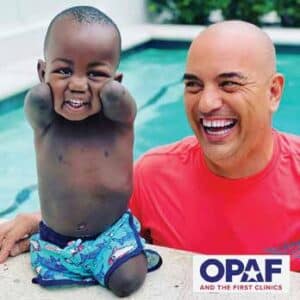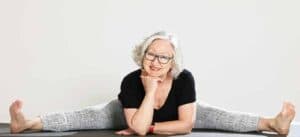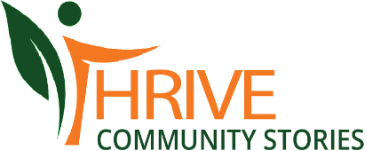 FIRST SWIM
FIRST SWIM
Here at the Orthotic and Prosthetic Activities Foundation (OPAF), we focus on the first. The first time an individual faces a challenge they’re not quite sure they can overcome. The first time they try an activity they have potentially already performed. Does this make it not the first? No, the difference in this first is a life-changing event has likely occurred and given them a chance to experience a first all over again, but this time from a different perspective. So many fears and unknowns can overwhelm you when living with limb loss or limb difference. A skill that you may at once had conquered, can seem so hard and far from your reach that leaves you wondering if you can do this. The truth is, you can, and it doesn’t matter how big or how small a goal, hurdle, or fear may be, because with the right people, techniques, and attitude, you can always experience a first.
Let’s define swim: to propel the body through water by using the limbs, fins, tail, or other bodily movement. First Swim teaches how to appropriately apply swimming as an exercise modality and review pool safety, transfers, and prosthetic limb management around the water. Furthermore, it reviews the basic elements of swim strokes and the compensations often required for individuals with limb loss or limb difference. Because after all, the definition of swim says that using limbs is not the only way to propel yourself through the water, you can do so with other bodily movement.
Our First Swim clinic has been continually developed and adapted throughout the years to ensure current techniques are kept up to date in this course and our goal is to familiarize yourself and your support system with the knowledge and resources necessary to keep active and safe within and around the pool, which is overseen and often led by our First Swim Director, Mabio Costa.
Mabio was born in Brazil with a congenital limb malformation. At the age of 12, Mabio had his left foot amputated below the knee and in 1982 joined the Brazilian swimming team and started triathlons in 1987. Mabio became the first para-athlete to participate and be awarded in a triathlon competition in South America. He moved to New York in 1990 and played a major role in the introduction and development of rules for the International Triathlon Union (ITU) for accepting para-athletes in world championships. He then went on to win the 1996 Cleveland ITU Triathlon World Championship, representing Brazil. After the events that occurred on September 11, 2001, Mabio decided to become a US citizen and represent Team USA as a triathlete. Soon after, he won the 2004 Portugal ITU World Triathlon Championship. Mabio was also chosen to be the flag bearer for Team USA during the opening ceremonies at the 2006 World Championships in Switzerland.
Mabio started with OPAF in 2010 and has helped grow OPAF’s First Swim program nationally. He was named OPAF’s First Swim Director in 2018. Mabio has a passion for teaching new amputees and individuals with limb differences how to swim, regardless of age. Mabio brings positivity and excitement to teaching swimming that is unmatched and, with his infectious smile that lights up the room, help guide participants to improve their ability to swim. Mabio’s most recent accomplishment is participating with his Triathlon relay team, “3 Guys 2 Legs,” and are the only disabled athletes competing against able-bodied athletes. They have taken a podium stand in every race, including a first-place finish in September 2021.
We are thrilled that Mabio will be returning to host our First Swim Clinic at the 2022 Amputee Coalition National Conference. You will not want to miss this course as Mabio will be bringing two years of smiles, training, laughter, compassion, and top-notch training to every participant at this event.
YOGA EVOLVES

Yoga means union, uniting, bringing together the many facets of our being into a coherent whole. The word conjures up images of people in the modern world doing complicated poses in classrooms, on mountain tops, by the beach, and in other public, open spaces. The freedom to breathe, move, get strong, and expand into the fullness of the yoga pose. When Covid-19 arrived in March 2020, everything changed. Yoga studios and classrooms had to stop teaching in-person classes and all freedom was gone.
I was fortunate to teach at a large yoga studio that immediately went into overdrive to figure out how to take their 115 yoga classes online. By the end of March, over half of the teachers and classes were back teaching their regular class schedule, and a month later almost all classes and teachers had transitioned to the Zoom universe. Today, 110 classes, including our Accessible/Amputee Yoga class, and 23 teachers have transitioned to Zoom and/or hybrid classes, which are live in-studio with simultaneous live-streaming. This is the new face of yoga, a new union evolving in response to changing circumstances.
So, we moved to live-streaming and the yoga world issues were solved, right? Well, not exactly. Teaching a three-dimensional practice in a two-dimensional world has its challenges. First, the student needs to be able to clearly see the teacher, and vice versa, to see enough detail that the pose can be fully and safely executed. Second, the student and teacher need to be able to communicate with each other if there are questions about the pose or if the teacher wants to verbally assist the student in an adaptation of the pose. This is particularly crucial for those who may not be able to, or desire to do the “classical” pose, and need to be guided in a variation of the pose, which is often the case with an amputee. Therefore, many yoga teachers adopted a modified teaching strategy, especially for newer students as well as for amputees and others with limb limitations. Modifications included:
- Teaching at a slightly slower pace to ensure all could see and safely do the poses.
- Teaching less difficult poses until the student fully understood and could safely move to more challenging poses, if desired.
- Teaching more breath work, range of motion (ROM) actions, and dynamic movement (breath coordinated with movement) such as cat-cow pose, and sun salutations rather than longer, static holds.
- Demonstrating poses from several angles to ensure a better 3D understanding: from the front, side, and at an angle.
- Demonstrating poses using pieces of furniture and other available home features, g., kitchen counters, dining room tabletops, and door frames.
- Teaching creative use of the chair to sit or support, including doing standing poses seated on the chair (or on the mat on the floor); this approach can be particularly helpful for amputees in the home environment.
And then there’s the issue of having adequate support in the form of yoga “props,” the tools of yoga that aid comfort, stability, and flexibility. These props are particularly helpful for amputees who may need to prop body parts during a pose.
- non-slip yoga mat — prevents slipping in standing poses; holds a yoga chair steady
- 2-3 thick yoga blankets — support body
- 2 yoga blocks — provide length to body parts; provide resistance
- yoga strap — secures body
- yoga bolster — supports body
- yoga chair — sitting and standing support
- wall space — standing support
Most students became creative with homemade versions of props — carpet padding (mat), thick woolen blankets or beach towels (yoga blankets), several books belted together (yoga block), cotton belt or bathrobe tie (yoga strap), thick throw pillow (yoga bolster), armless dining room chair (yoga chair), and a large piece of sturdy furniture for standing against (wall). Two years post-lockdown the yoga world continues to evolve to accommodate amputees whether at home or in the studio. Lately, some in our Accessible/Amputee Yoga Class have expressed a desire for coming to a hybrid class so we may take the class hybrid in Fall 2022. Yoga is always evolving to meet current needs.

